Acer Aspire TimelineU M3: Life on the Kepler Verge
by Dustin Sklavos on March 13, 2012 5:56 PM ESTBattery Life
Getting detailed specifications for the Acer TimelineU M3 has been a little bit difficult; the notebook isn't on Acer's site yet (despite apparently having been released into the wild) and our reviewer's guide is a bit light on details. The box for it claims a meager 3-cell battery, but we're told it has a healthy 55Wh of capacity. That seems pretty dense, but as you'll see it's believable.
Unfortunately due to the crunch we don't yet have results for media playback, but those will be added as soon as humanly possible.
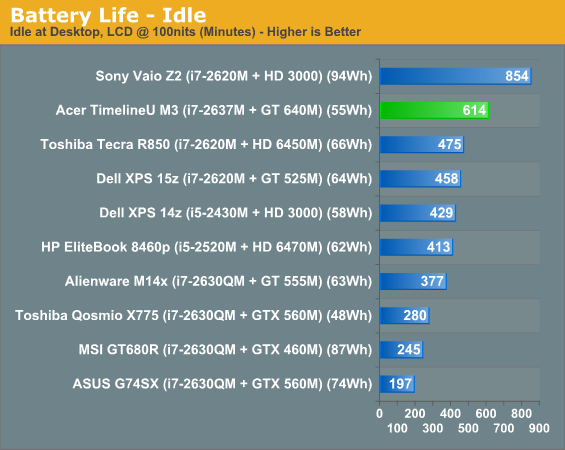
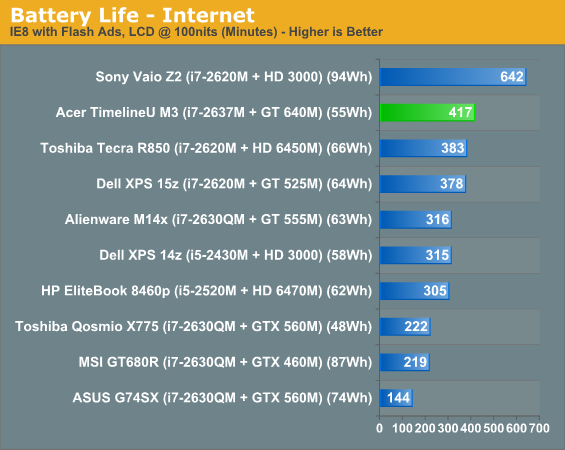
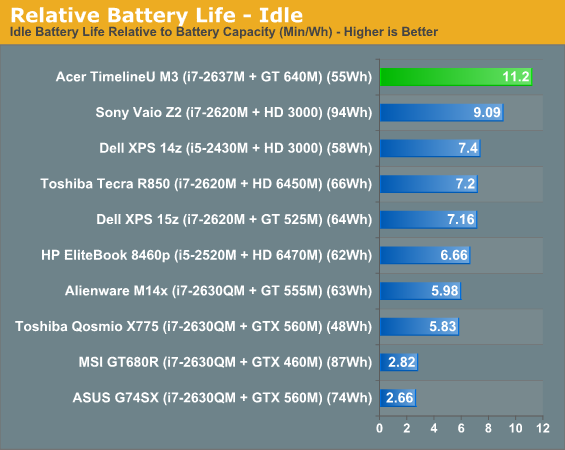
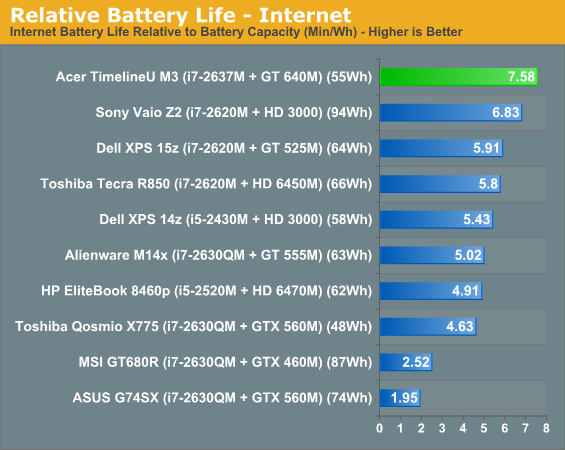
The TimelineU M3 absolutely rocks socks on the battery. NVIDIA's Optimus technology is in full effect here, and as a result the M3 is able to meet and beat the advertised eight hours of battery life that even the reviewer's guide for the M3 claims. This is one place where using the ULV i7-2637M does seem to pay major dividends compared to the full voltage chips.
Heat and Noise
Heat and noise are two more places where having that ULV chip seems to help the M3. While load noise isn't exactly ideal, it's only roughly 41dBA under load, and that's only when the GPU is being stressed. Meanwhile, no hot spots seem to develop on the top surface of the notebook. That said, top-center on the bottom of the M3 does get a bit warm; it's not uncomfortably hot and certainly won't scald you, but there's definitely a single sharp source of heat inside the M3.
Screen Quality
At the risk of digressing, when I used to write for NotebookReview I found myself trying to eschew talking about the speakers of the notebooks I reviewed whenever possible because the results were the same 99% of the time. That's remained true here; notebook speakers are typically only worth talking about when they're not terrible. The reason I bring this up is because I'm beginning to feel the same way when testing the notebook screens. It's obviously useful information, but this is a component that almost always underwhelms, and the same is true again with the Acer TimelineU M3.
While the 1366x768 resolution of today's mediocre TN panel is ideal for our bandwidth-constrained GPU, it doesn't require any feat of prestidigitation to say that the comments on this review will once again light up with well-founded complaints about a 15.6" screen running this resolution natively. Frankly it's just inadequate for a notebook this size, and we're going to keep harping about these subpar panels until manufacturers wise up and start getting it right.

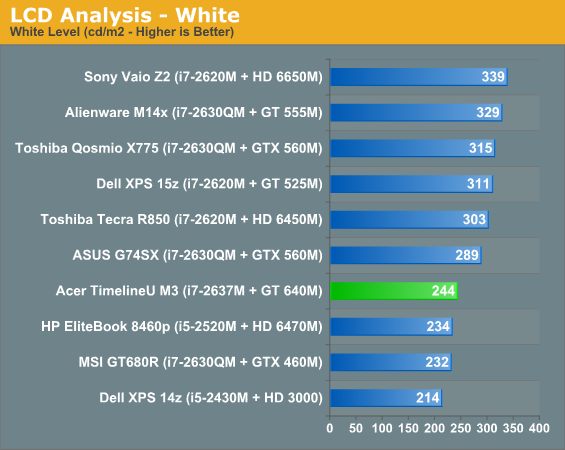

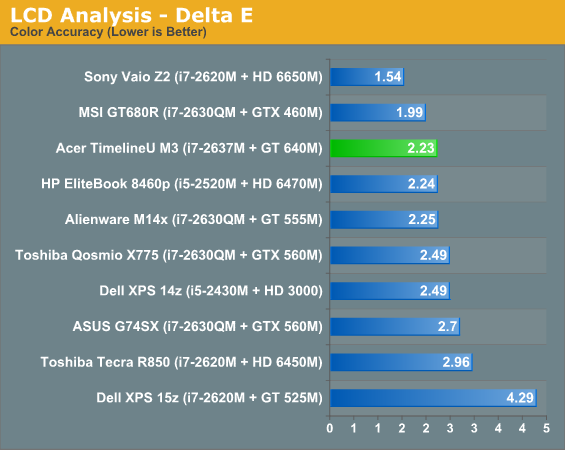
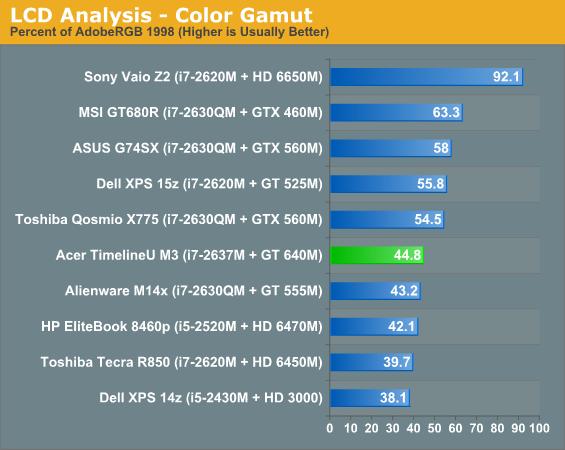
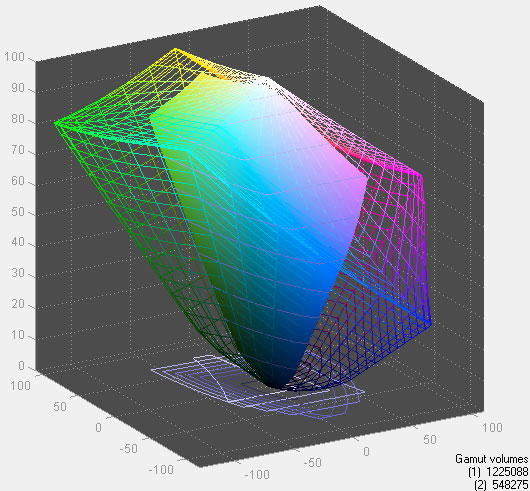
You can see from our test results that it doesn't necessarily have to be this bad. While the M14x's screen is underwhelming in places, it also runs at a superior 1600x900 resolution. The Sony Vaio Z2 may be a premium notebook (or at least a premium-priced one), but you at least see where some of that purchase price is going: a fantastic, high-resolution screen.
Meanwhile, the Acer TimelineU M3 sports the industry-standard dismal TN panel with weak viewing angles, low contrast, and low color accuracy and quality. This needs to change, and there's really no reason to settle for a crappy display when you're putting in 256GB SSDs.
And let's be clear about the costs: when an end user can go out and purchase a replacement AU Optronics B156HW01 v4 display for under $100 (compared to around $60 for a typical 1366x768 panel), the cost savings can't be that much for the laptop makers. Granted, with ultrabooks the manufacturers are also looking to get the thinnest panels they can find (another misguided goal in my book: thinness while sacrificing keyboard and display quality just doesn't make sense), but there are still much better 15.6" displays out there that would only increase the BOM by $50 at most.


_thumb.jpg)
_thumb.jpg)
_thumb.jpg)
_thumb.jpg)
_thumb.jpg)








76 Comments
View All Comments
Exchequer - Wednesday, March 14, 2012 - link
It is clear you are NOT a gamer... I hace combined my gamign rig intentionally with a 1680x1050 screen, why? Because it MATTERS for your framerate.1024x768=768k
1280x1024=1.2M
1680x1050=1.76M
1920x1080=2M
1366x768=1M
Your talking about is 5M
That is pure madnes... Even if you go from 1M pixels to 2M pixels, this mean your framerate will drop down 50%... E.g. if you had 50 fps before it will end up near 25 fps. To talk about 5M pixels means you really have absolutely no clue about gpu's and games...
Of course you can lower the resolution of your game but, as anyone that ever tried this will know, if you move away from the native resolution screens become very ugly. Your better off playing native on a lower resolution than picking this resolution on a higher res panel.
kmmatney - Wednesday, March 14, 2012 - link
When you have pixels that small, things actually scale quite well, so going to a lower resolution for a game is no big deal.I agree that a 1680 x 1050 screen is great for mainstream gaming - it's a good compromise between having a nice big screen, and not too many pixels to push.
airmantharp - Wednesday, March 14, 2012 - link
Did you seriously just say 1680x1050 for gaming?That's great, if you can't afford a video card, and I'm aware that not everyone can.
But let me tell you, gaming on a 30" 2560x1600 IPS screen is something to behold. Battlefield 3, Skyrim, Mass Effect 3, The Old Republic, all look and play amazing when driven by a pair of HD6950 2GB cards.
Exchequer - Saturday, March 17, 2012 - link
First of all we are talking here about mobile gaming... Even if you get an insanely expensive laptop with sli/crossfire you still wont have enough fps for a 30 inch screen with that resolution...Furthermore crossfire results in microstutter so thats not an ideal solution, it pretty much ruins the game.
On pc gaming I once bought an 8800 GTS 640mb for 320 euro when it was just released (probablyt wrong priced should be 450 euro), 6 months later the 8800GT was introduced at half price. Since then I learned my lesson and got the gtx 260 for 140 euro (and got 90 back for the 8800gts), after that a gtx460 hawk for 165 euro. If you stick with your 1680x1050 panel you can run all games with AA without any problems for at least a year for about 50-60 (because each time you get 90-100 back for your old card). If I want to play bf3 on 1920x1080 I have to upgrade to a 560ti which would cost me 220 euro while resulting in the same detail settings and fps...
Bols - Thursday, March 15, 2012 - link
But you are so very wrong (and angry), young padwan.The beauty of a 2880x1800 screen is that it scales perfectly down to 1440x900, which would allow it to be driven by a mid-class GPU for fast FPS-games, and you will not be able to see that there is any scaling going on. (There isn't - every pixel in the 1400-domain is just shown as four pixels). For serious use, you can cram in four times more information and text in the 2800-resolution. If you working with text, like programming, screen estate matters.
And you should ease up on the assumptions. I am an ex-fps-junkie, but I still care about framerate.
Finraziel - Thursday, March 15, 2012 - link
Double the pixels is half the framerate? Right, and there we stop taking you seriously... You read Anandtech yet you don't know there are lots of different possible bottlenecks and they are not all affected by resolution?Aside from that I agree, scaling isn't nearly as bad as people make it out to be on a proper high resolution screen. I've regularly done it both on laptops and on my 24" 1920x1200 display and if you can live with lower res I don't see how you can be so picky to whine about a bit of blurring from the scaling. Maybe if you play text-heavy games, but those tend to be less sensitive to framerate, so it works out nicely.
Exchequer - Saturday, March 17, 2012 - link
It is... I have an old Philips 17 inch TFT (25ms from 2003 so 9 years old!) as secondary monitor with 1280x1024. My main monitor is a samsung 2253BW (2008, 2ms), which is regarded as a high quality monitor. If I put the 2253BW on 1280x1024 (including black bars) you get about the same screen surface. The 17 inch is 27 cm height and the 22inch is 30cm. However the image quality is a LOT worse. If all you can run is 1280x1024 (gpu limited) than you are 100% better off with the old 17inch 5:4 panel as compared to downscaling the modern 22inch panel.Besides gaming it is of course personal preference. Back in the day you could get a 1680x1050 22 inch or a 1680x1050 20 inch, or a higher resolution 22 inch. However this results in very small text on your OS forcing you to use larger icons which (in the old days) were not as pretty ^^. Small icons get annoying pretty quickly. Anyone that has been wearing contact lenses for some years will know what im talking about:D.
Exchequer - Saturday, March 17, 2012 - link
"Double the pixels is half the framerate? Right, and there we stop taking you seriously...´`Maybe you should not only visit anandtech but also take a look at techpowerup...
http://www.techpowerup.com/reviews/Zotac/GeForce_G...
2560x1600 48 fps
1680x1050 85 fps
1280x1024 109 fps
If you are talking about 5M pixels (the post that I replied to then I can assure you that you will be gpu imited and that scaling will be completely lineair...
ps since sandy brige its hard to be cpu limited with a single gpu ^^.
JojoKracko - Wednesday, March 14, 2012 - link
Yes, disgraceful. I have to agree. Lets hope that Apple also forces a return to the infinitely more logical 16x10 format for laptops. 16x9 is simply cost saving BS which I equate to skimping on the quality of the screen.Make it 16x10, IPS, and I will gladly, GLADLY, kick the vendor an extra $150.
If they can put a 2560x?? IPS panel in a $500 iPad (not 3) then they can damn well do the same in $900 and up laptops.
All we need is ONE manufacturer to set the example, (and do it well for pete's sake, don't skimp on the keyboard to compensate), and the HUGE SALES will show all of the others that this is what they should have been doing all along.
If they would have put a 1600x1000 quality TN panel into THIS laptop, I would have been a buyer for $100 over list price. As is though, it is useless crapola to me.
Props for the mSata SSD and the EMPTY drive bay. Although, I'd prefer two fullsized bays and the ability to buy my own SSD and install it along with the crap HDD they would include.
JojoKracko - Wednesday, March 14, 2012 - link
Hey, if Asus can put a 1080P IPS Matte screen in an $1100 UX31A, then every other laptop maker sure as heck better start doing the same. It is just crazy that it has taken this long for the first quality laptop display to appear.Let me say it again.
1080P IPS Matte Screen
Just do it!
http://www.notebookcheck.net/Asus-to-release-the-Z...
This one, or hopefully a G75 with a similar spec'd screen, is something I'm looking forward to buying in the near future. Not things like this acer with the low res, low spec screen.
Review the UX31A next please Anandtech.